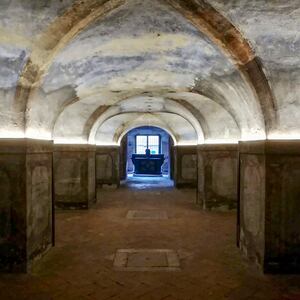Health
Crypt of Milan’s Historic Hospital Reveals Secrets of the Poor

A significant archaeological discovery has emerged from the depths of Ospedale Maggiore, a historic hospital in central Milan. Between the years of 1637 and 1693, the crypt beneath this facility served as the final resting place for approximately 10,000 patients. Established in 1456 by the Duke of Milan, the hospital, known as Ca’ Granda or the Big Factory, was dedicated to providing care for the sick and injured, particularly among the city’s working poor.
This institution is notable for being Europe’s first known secular hospital. According to Folco Vaglienti, a historian at the University of Milan, “Unlike the religiously affiliated institutions of the time, it welcomed people of any ethnicity or religion, marking a significant shift to a more universal approach to healing.”
Archaeological Insights Unveiled
In 2018, a team led by bioarchaeologist Mirko Mattia began an extensive examination of the remains found within the crypt. This research aims to uncover the health and living conditions of the impoverished population in Milan during the 17th century. The analysis of the skeletal remains could provide vital insights into the diseases and challenges faced by these individuals.
The crypt’s excavation has allowed researchers to explore how social conditions influenced health outcomes during this period. Initial findings suggest that many of the deceased suffered from malnutrition and infectious diseases, which were prevalent among the urban poor of that era.
The work of Vaglienti and his team not only sheds light on the past but also highlights the hospital’s progressive role in providing care to marginalized groups. The findings challenge the narrative of healthcare in historical contexts, illustrating a time when the sick were treated without discrimination.
Legacy of Ca’ Granda
Ca’ Granda’s establishment marked a pivotal moment in healthcare, transitioning from religious to secular models of care. This approach laid the groundwork for modern hospitals, emphasizing inclusivity and compassion in healthcare delivery. The Ospedale Maggiore continues to operate today, standing as a testament to its rich history and ongoing commitment to serving the public.
As the research progresses, the team hopes to delve deeper into the crypt’s secrets, offering a clearer picture of the lives and struggles of Milan’s poor during the 17th century. This ongoing work not only serves academic interests but also enriches the cultural heritage of Milan, ensuring that the stories of those who suffered are not forgotten.
In uncovering these historical truths, the project amplifies the importance of equitable healthcare, a theme that resonates strongly in contemporary discussions about health and social justice. The legacy of Ospedale Maggiore emphasizes the necessity for healthcare systems to evolve in ways that prioritize care for all, regardless of background or circumstance.
-

 Sports2 months ago
Sports2 months agoNetball New Zealand Stands Down Dame Noeline Taurua for Series
-

 Entertainment2 months ago
Entertainment2 months agoTributes Pour In for Lachlan Rofe, Reality Star, Dead at 47
-

 Entertainment3 weeks ago
Entertainment3 weeks agoNew ‘Maverick’ Chaser Joins Beat the Chasers Season Finale
-

 Sports2 months ago
Sports2 months agoSilver Ferns Legend Laura Langman Criticizes Team’s Attitude
-

 Politics3 weeks ago
Politics3 weeks agoNetball NZ Calls for Respect Amid Dame Taurua’s Standoff
-

 Entertainment2 months ago
Entertainment2 months agoKhloe Kardashian Embraces Innovative Stem Cell Therapy in Mexico
-

 Sports2 months ago
Sports2 months agoGaël Monfils Set to Defend ASB Classic Title in January 2026
-

 World3 months ago
World3 months agoPolice Arrest Multiple Individuals During Funeral for Zain Taikato-Fox
-

 Entertainment1 month ago
Entertainment1 month agoTyson Fury’s Daughter Venezuela Gets Engaged at Birthday Bash
-

 Sports1 month ago
Sports1 month agoHeather McMahan Steps Down as Ryder Cup Host After Controversy
-

 Entertainment1 month ago
Entertainment1 month agoTyson Fury’s Daughter Venezuela Gets Engaged at Birthday Bash
-

 World6 days ago
World6 days agoSevere Winds Hit New Zealand, Over 100 Flights Canceled













